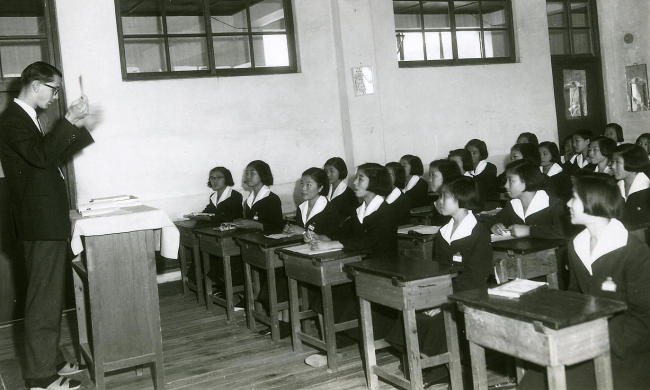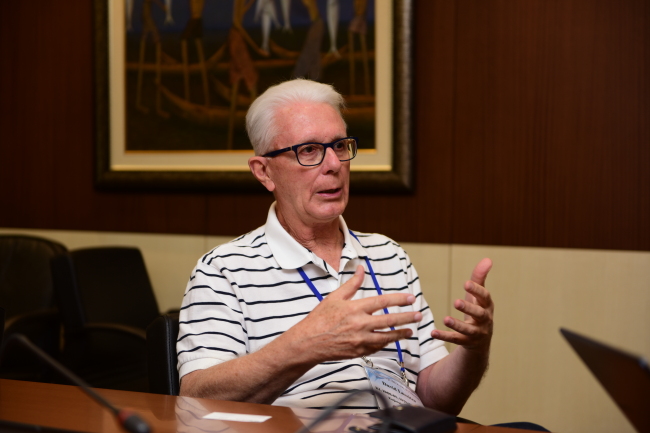'Korean thread from Peace Corps days is woven through my life'
By Shin Hyon-heePublished : Sept. 13, 2016 - 14:53
Amid the escalation of the Cold War, David Lassiter, then a 22-year-old college student in international relations, landed at Gimpo airport in 1966 as part of the maiden batch of US Peace Corps volunteers tasked with aiding South Korea’s post-war reconstruction.
A lover of Chinese food who had not traveled outside the US and who was largely ignorant of Korean society, he came directly into solitude, homesickness and “culture shock,” among other snags, as soon as he began teaching English at Euijeongbu Girls Middle & High Schools in Gyeonggi Province.
A lover of Chinese food who had not traveled outside the US and who was largely ignorant of Korean society, he came directly into solitude, homesickness and “culture shock,” among other snags, as soon as he began teaching English at Euijeongbu Girls Middle & High Schools in Gyeonggi Province.

The three years, however, shaped his entire life in a way that he never thought possible. After his return home, Lassiter pursued a master’s degree in Asian studies at Harvard University and worked at the Peace Corps headquarters in Washington, providing training for incoming volunteers to Korea.
In 1975, he came back to Korea as a director of the Pearl S. Buck Foundation, a humanitarian organization focusing on multicultural families, and the next year his first daughter was born at a Seoul hospital. From 2009-14, he also served as a board member of Friends of Korea, a friendship group founded in the 1990s by former Peace Corps volunteers.
“I look at it as a Korean thread that’s woven through my life constantly. … I learned so much about Korean society and culture while I was here and also increased my curiosity terrifically,” said Lassiter, 72.
“In 2008, I brought my oldest daughter with me and took her back to where she was born, and she was also pregnant with her first child at the same time. So the circle of life was continuing and that was very special.”
Aside from the country’s rapid economic ascent and across-the-board greening works, another startling moment came during the 2008 revisit program that also included a trip to the school in Euijeongbu.
Lassiter initially declined to go, assuming that few, if any, traces would remain after 45 years. There, the city had indeed completely changed such that he could recognize “nothing at all.” And the school had even moved to a different location.
Then to his utter surprise, a former student who was now head of a parent-teacher association greeted her aged past instructor at the newly built school.
“So she had organized a wonderful reception for me, and she had managed to find a few of my co-teachers and a few students. It was very, very emotional,” Lassiter said, pausing for a moment to hold back tears. “It was a wonderful gift.”
Marking the 50th anniversary of the US volunteers’ service, the Korea International Cooperation Agency on Tuesday invited Lassiter and some 90 Peace Corps members and their families to Seoul. Through 1981, around 1,700 volunteers took part in educational, public health and other various programs.
In 1975, he came back to Korea as a director of the Pearl S. Buck Foundation, a humanitarian organization focusing on multicultural families, and the next year his first daughter was born at a Seoul hospital. From 2009-14, he also served as a board member of Friends of Korea, a friendship group founded in the 1990s by former Peace Corps volunteers.
“I look at it as a Korean thread that’s woven through my life constantly. … I learned so much about Korean society and culture while I was here and also increased my curiosity terrifically,” said Lassiter, 72.
“In 2008, I brought my oldest daughter with me and took her back to where she was born, and she was also pregnant with her first child at the same time. So the circle of life was continuing and that was very special.”
Aside from the country’s rapid economic ascent and across-the-board greening works, another startling moment came during the 2008 revisit program that also included a trip to the school in Euijeongbu.
Lassiter initially declined to go, assuming that few, if any, traces would remain after 45 years. There, the city had indeed completely changed such that he could recognize “nothing at all.” And the school had even moved to a different location.
Then to his utter surprise, a former student who was now head of a parent-teacher association greeted her aged past instructor at the newly built school.
“So she had organized a wonderful reception for me, and she had managed to find a few of my co-teachers and a few students. It was very, very emotional,” Lassiter said, pausing for a moment to hold back tears. “It was a wonderful gift.”
Marking the 50th anniversary of the US volunteers’ service, the Korea International Cooperation Agency on Tuesday invited Lassiter and some 90 Peace Corps members and their families to Seoul. Through 1981, around 1,700 volunteers took part in educational, public health and other various programs.

On Monday, they celebrated in an exhibition of more than 1,200 donated artifacts carrying the memories of their days here at the National Museum of Korean Contemporary History in Seoul.
Among the items are a notebook, letters and photos given by former US Ambassador to Korea Kathleen Stephens, who also taught English at a middle school in Yesan, South Chungcheong Province, from 1975-77.
“It gives you a picture of times, not just the kind of history of Peace Corps in Korea, but also a window into Korean history,” the former envoy told The Korea Herald.
“The other thing the exhibition is to show (is) how the experience of being in Korea at that time (was) for so many of us, and how it changed our lives, and certainly of interest in terms of US-South Korean relations and contemporary Korean history.”
For Lassiter, his career involving repeated returns to Korea is the “easy part” to articulate when describing what Korea and his Peace Corps time have meant to him.
“The part that’s not easy to articulate is why do I keep coming back, why do I keep things Korean, why did I organize this week,” he added.
“It’s just ‘maeum’ (heart). I can’t put words to that. The connection is deep, and the museum opening yesterday was a beautiful journey -- everlasting friendship.”
By Shin Hyon-hee (heeshin@heraldcorp.com)
Among the items are a notebook, letters and photos given by former US Ambassador to Korea Kathleen Stephens, who also taught English at a middle school in Yesan, South Chungcheong Province, from 1975-77.
“It gives you a picture of times, not just the kind of history of Peace Corps in Korea, but also a window into Korean history,” the former envoy told The Korea Herald.
“The other thing the exhibition is to show (is) how the experience of being in Korea at that time (was) for so many of us, and how it changed our lives, and certainly of interest in terms of US-South Korean relations and contemporary Korean history.”
For Lassiter, his career involving repeated returns to Korea is the “easy part” to articulate when describing what Korea and his Peace Corps time have meant to him.
“The part that’s not easy to articulate is why do I keep coming back, why do I keep things Korean, why did I organize this week,” he added.
“It’s just ‘maeum’ (heart). I can’t put words to that. The connection is deep, and the museum opening yesterday was a beautiful journey -- everlasting friendship.”
By Shin Hyon-hee (heeshin@heraldcorp.com)










![[Hello India] Hyundai Motor vows to boost 'clean mobility' in India](http://res.heraldm.com/phpwas/restmb_idxmake.php?idx=644&simg=/content/image/2024/04/25/20240425050672_0.jpg&u=)








